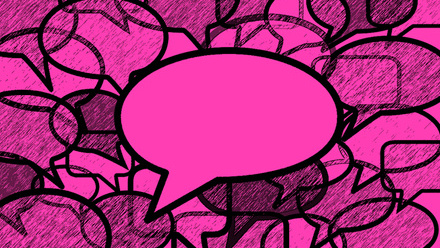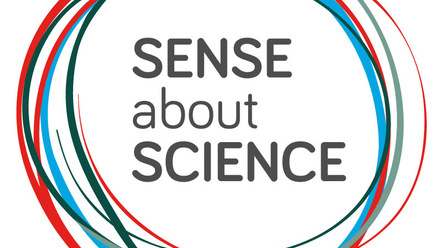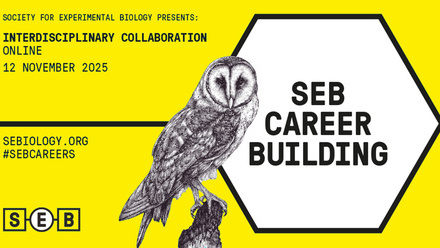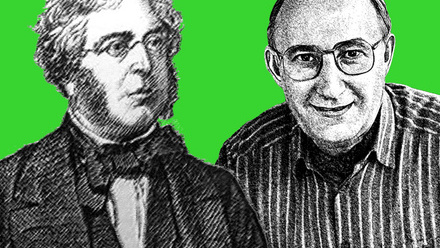How to write an eye-catching title for your scientific poster that will attract visitors
"Your poster's eye-catching title starts with your abstract. SEB advises that your poster title is the same as on your abstract so it can easily be found at the conference. Please note that title changes are generally not possible after abstract submission closes. Take a moment to review these tips before submitting to make the most of your presentation!"
Poster sessions are a great way to learn about new and innovative research at a glance. They’re also a great way for scientists and researchers to share their findings and perspectives on their work. The thing is that poster sessions usually involve many, many posters. With that in mind, how can you design your poster in a way that grabs attention and attracts visitors?
When we ask this question in our poster design and delivery workshops, we get a wide variety of answers. For some participants, it’s the overall poster design that draws the eye. For others, attention-grabbing images and good use of colour and font are what compels them to move closer and read more. Most, however, agree that it’s the poster title that piques their interest.
Here’s what we’re going to cover today – feel free to jump to the part that interests you.
- Why is your scientific poster title important?
- How long should your title be?
- Three tips to make your poster title pop!
- What to do if you can’t think of anything
- Things to avoid (most of the time)
Why is your scientific poster title important?
Sure, design, visuals and content are important, but in a huge poster session, people are likely to be walking past or standing in front of posters. That means that often, the only part of a poster that a potential visitor will see is your big, beautiful title. And if that title is interesting, too, you’re likely to get more visitors.
But that’s not the only reason you need an interesting title.
Most conferences ask for poster abstract submissions well in advance of the event itself. This enables meeting organisers to put together a list of posters, which is publicised on their meeting website in advance of the event. Different disciplines and organisers provide different levels of detail, but at a minimum, this list typically includes:
- Poster title
- Presenter name
- When the poster is presented
In addition, some organisers include the poster abstract, and for hybrid and online academic meetings, the whole poster is sometimes available to view, either as a PDF or another digital format tailored to the event.
This list of poster titles and abstracts is incredibly helpful for time-poor meeting attendees who know that they won’t have time to visit every poster presenter at a conference. These attendees—and there are many of them—take time to go through the list of poster titles in advance, and choose which poster presenters they want to visit during a poster session.
If only the poster title and presenter name are listed, the poster title will probably be one of the main factors in deciding which poster presenter to visit, or whether to invest time reading the abstract (if it’s included in the online catalogue).
Finally, if your poster is listed on a conference web page that is open to the public, the keywords that you include in your title will help your poster be found through the search engines.
The bottom line: your title is probably the MOST important aspect of your poster if you want to attract visitors to a live poster session, as well as opens, downloads and reads from the conference website. Taking time to get it right is a good pre-conference investment.
Now that we’ve established why your poster is important, let’s tackle the easy bit: how long should your title be?
How long should your title be?
The short answer to this question is: as short as possible but as long as necessary. Helpful, huh?!
Seriously… the best length for your poster title is probably somewhere between 7 and 10 words.
Why?
Short titles are easy to scan in online poster lists and catalogues and read over the heads of other people at an academic meeting.
Short, interesting titles are memorable, so that they stick in the minds of poster session visitors – even if they don’t visit your poster during the session, you have a better chance of being contacted later or starting a conversation about your poster during a coffee break.
Short titles take up less space, so when it comes to design, you can make them large and eye-catching, too.
But…
The thing is that many academic posters present complex data and some poster designers feel that they need to provide some context within the title.
So what’s a scientist or researcher to do in this situation?
The answer is to use a title and a sub-title.
Start with a short, punchy title that gets to the point or attracts attention.
Then follow that with a sub-title to provide additional context if needed, is a way to overcome the problem of having a looooongggg poster title that no one can read in the poster session (because the text is too small). How long? Again, as short as possible. Typically 7-15 words.
On the downside, this means that your title will take up more space in your poster design. Remember that the longer your sub-title is, the smaller the font will need to be in your poster (or your header area will take up a lot of space that you could be using for your findings!)
On the upside, however, this approach means that:
- You have both a short title AND the context that you need.
- You can add a few keywords to your title, which might be useful for online searches through the conference website.
Tips to make your poster title POP
Tell people exactly what you found in your research
Some scientific poster titles read like a mystery. For example:
The Effect of Substance A on Protein B
Why hide what you’ve discovered? Instead, get to the point and tell your audience what they can expect to learn more about from your research. For example:
|
Instead of this… |
Say this… |
|
The Effect of Substance A on Protein B |
Substance A Inhibits Production of Protein B |
|
Temperature-Dependent Sex Determination in Fish |
Water Temperature Determines Sex of XYZ Fish Species |
The bottom line: use your title to summarise your most important findings – briefly!
No results yet? No problem. The next approach might work for you.
Ask a question. And hint at the answer in your sub-title, if you have an answer.
Questions are incredibly powerful. When we see a question, our brains try to answer the question, which means that questions are useful in engaging an audience – even if they don’t want to be engaged!
Using a question in your title is a great way to arouse curiosity, get people interested in your topic and make them think, “Ooh, I’d like to know the answer to that.”
Questions are also easy ways to write a title because most research starts with a question.
Here are a few ways to use questions in your title:
You can choose to ask a question in your title and only “reward” people with the answer if they visit your poster (or read your poster online). For example:
- Is Cognitive Inflexibility Associated With Abuse In Parental Relationships?
Your poster then serves as the answer.
You can ask a question and hint at what your poster will explore in more depth. For example:
- Will Manatees Still Exist In Florida In 2100?
The effect of watercraft accidents and cooler winders on populations.
You can ask a question and use a sub-title to point to your stage of research. For example:
- Are Salmon Lice In The Pacific Ocean Resistant To Parasiticide Treatment?
The early results of applying the XYZ method.
Struggling to think of a question? Think about how your research answers things like:
- What…
- Where…
- When...
- Why…
- Who/what…
- How…
Be provocative, “clever”, or humorous
This approach isn’t for everyone and you may feel that it doesn’t have a place at the scientific meeting or conference that you are attending. Only you can decide if this is a good approach for you.
A benefit of having a provocative or humorous title is the element of surprise: it’s likely to stand out and prompt people to visit or read your poster, simply to find out more. If you use a title like this, be sure to have a poster with content that answers questions and meets expectations. Here are a few examples:
- Where There’s Smoke, There’s Fire
How cigarette consumption and ABC - Smelly Greeks:
A smell walk through Ancient Athens - Fantastic Yeasts And Where To Find Them:
The hidden diversity of dimorphic fungal pathogens
(https://pubmed.ncbi.nlm.nih.gov/31181385/) - Don’t even think about it:
How cognitive bias is getting in the way of thinking about climate change
User warning: only use this approach if you feel that it is authentic to you as a researcher or scientist, and if you are confident that your audience will understand the approach you are taking.
Bonus: Know your audience and tailor your language accordingly
This may seem almost too obvious to mention, but it’s easy to get stuck in our worlds of scientific and academic jargon, and simply assume that everyone knows what we are talking about!
If you’re presenting at a conference full of like-minded researchers who work in the same field as you and who use the same jargon, feel free to use that language.
If, however, you are at a conference where people are attending from a variety of research backgrounds, where the same technical term might mean different things to different people, adjust your language in your title to make it clear what your research was or is about.
And of course, if you’re expecting non-experts and lay people to attend the session—policy makers, high school students, the media and so on—then your job is to write an interesting title that everyone can understand.
What to do when you can’t think of anything
If words aren’t your strong point and you are struggling, you might want to consider turning to AI for help. Let’s be clear: you’re not using AI to write your research or plagiarise, but rather as a source of inspiration to help you write an attention-grabbing title.
Use AI tools to cut down on the amount of time you spend thinking about and crafting the perfect title. ChatGPT is one of the most well-known, but many others exist and new LLMs (large language models) are being released all the time, some of which have been created with scientists and researchers in mind. For example, at the time of writing, we came across writefull (https://x.writefull.com/title-generator), and more will no doubt emerge as the technology improves.
When using AI, you need to give the tool some prompts. For example:
- Create an attention-grabbing title about <<insert your topic name>> based on the content in my abstract below <<paste abstract below>>.
You can also simply enter your title and abstract, plus results and discussion if relevant, into your preferred AI tool and add prompts like:
- Generate 10 titles based on the title and content above. Each title should be 7-10 words in length, use active voice, and focus on the results of the research.
There are many guides online about how to use prompts, so dive into the search engines and try this out.
Things to avoid – most of the time
It’s easy to get excited about your research but your title – and indeed, your scientific poster – isn’t usually the right place for words, adjectives and phrases that convey bias or human feelings.
Of course, this depends on the context, your personality, and how you want to come across. For example, an earlier example about yeasts (“Fantastic Yeasts and Where to Find Them: the Hidden Diversity of Dimorphic Fungal Pathogens”) uses the word “fantastic”, and the title itself gives a nod to fantasy author J.K. Rowling’s 2001 book, “Fantastic Beasts and Where to Find Them”. In some settings, this would be inappropriate.
Another exception is if your poster is about your experience of conducting science: perhaps you’re creating a poster to present to high school students about what it’s like to “be a scientist”, and you may find that using words, adjectives and subjective viewpoints is exactly what you need to humanise your message.
And that’s it!
You now have a wealth of information at your fingertips to help you craft a catchy title for your scientific or academic poster.
Go forth and create: you can do this!
--
This post was written by Suzanne Whitby of SciComm Success (https://www.scicommsuccess.com). SciComm Success creates practical, engaging communication training and workshops, like Poster Design and Delivery (https://scicommsuccess.com/science-communication-training/poster-design-skills-for-scientists-and-researchers/), for researchers and scientists who want to promote their work effectively and communicate better: with non-experts, fellow-researchers and colleagues alike.
Learn more about SciComm Success here → (https://www.scicommsuccess.com)
--
If you liked this post, you might be interested in the following SEB events with Suzanne Whitby:






